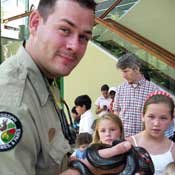Bryan Fedrick was not always fond of snakes. In fact, he was afraid of snakes until age 12 or 13. Now, however, the 34-year-old is a herpetologist who has been teaching snake safety since 2003.
His interest in snakes and wildlife has taken him far. Fedrick currently works as a wildlife biologist for the National Guard and a field associate for the Mississippi Museum of Natural Science. This summer, there will be no shortage of snakes in Mississippi, as they are more abundant when the weather heats up, making it important to stay safe if you encounter one.
"When you see a snake, the best thing to do is to leave it alone," Fedrick said. "Take a few steps back and walk away. Most injuries happen when people try to catch, kill, harm or harass the snake."
Of Mississippi's approximately 40 species of snakes, Fedrick said six species are venomous. Five of the species are pit vipers that differ from non-venomous snakes by having triangle-shaped heads and elliptical pupils. While non-venomous snakes have a double row of scales under their tail, pit vipers have a single row.
The sixth species of venomous Mississippi snake is the coral snake, which has all the features of non-venomous snakes, except for its color pattern. Fedrick uses a nursery rhyme to differentiate coral snakes from non-venomous snakes: "Red on yellow, kill a fellow. Red on black, friend of Jack."
If you are one of the millions of Americans with a snake phobia, you will probably keep your distance from them this summer, but Fedrick said people should value them nonetheless.
"Snakes play an important role in the ecosystem and, although you may not like them, you should always respect them," he says.
Fedrick leads interactive discussions about snakes at the Mississippi Museum of Natural Science's Snake Day June 5 from 10 to 11 a.m. and from noon to 1 p.m., where he will discuss the difference between venomous and non-venomous snakes in Mississippi. The museum will exhibit live snakes from 10 a.m. to 3 p.m. Call 601-576-6000 for more information.



Comments
Use the comment form below to begin a discussion about this content.
comments powered by Disqus